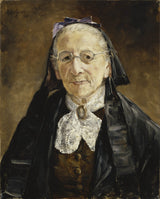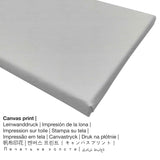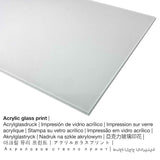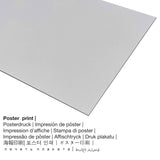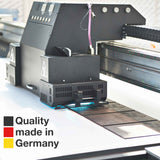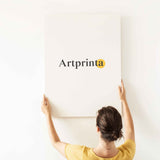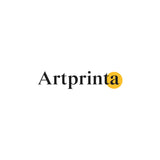Ernst Josephson, 1880 - Oriakụ Hanna Marcus - mbipụta nka mara mma
Ụtụ gụnyere. Mbupu gbakọrọ na ndenye ọpụpụ.
Kedu ụdị ngwaahịa nka anyị na-ewetara gị?
In 1880 onye omenkà Ernst Josephson painted the impressionist masterpiece. The over 140 year old original was painted with the size: Ogologo: 62 cm (24,4 ″); Obosara: 50 cm (19,6 ″) Ekebere: Elu: 82,5 cm (32,4 ″); Obosara: 69,5 cm (27,3 ″); Omimi: 7 cm (2,7 ″) ma were ihe osise ese Usoro of oil on canvas. This artwork is included in the National Museum nke Stockholm digital art collection. The masterpiece, which belongs to the ngalaba ọha is provided with courtesy of Nationalmuseum Stockholm & Wikimedia Commons.The creditline of the artpiece is: . Furthermore, alignment is Eserese ya na oke nke 1: 1.2, nke pụtara na ogologo bụ 20% mkpụmkpụ karịa obosara. The poet, painter Ernst Josephson was an artist from Sweden, whose art style was mainly Impressionism. The Swedish artist was born in 1851 in Stockholm, Stockholm county, Sweden and deceased at the age of 55 na 1906 na Stockholm, Stockholm County, Sweden.
Data nka ahaziri
| Aha nke ihe nka: | "Mrs Hanna Marcus" |
| Nhazi nka nka: | sere |
| Category: | nkà nke oge a |
| Century: | 19th narị afọ |
| Ekepụtara: | 1880 |
| Afọ nka: | ihe dị ka afọ 140 |
| Usoro izizi: | mmanụ na kwaaji |
| Akụkụ nke nka nka izizi: | Ogologo: 62 cm (24,4 ″); Obosara: 50 cm (19,6 ″) Ekebere: Elu: 82,5 cm (32,4 ″); Obosara: 69,5 cm (27,3 ″); Omimi: 7 cm (2,7 ″) |
| Ụlọ ihe ngosi nka: | National Museum nke Stockholm |
| Ebe ngosi nka: | Stockholm, Obodo Stockholm, Sweden |
| ibe weebụ: | National Museum nke Stockholm |
| License: | ngalaba ọha |
| Site n'aka: | Nationalmuseum Stockholm na Wikimedia Commons |
Tebụl nchịkọta ihe nkiri
| Aha onye nka: | Ernst Josephson |
| Aha ndi ozo: | Josephson Ernst, יוספזון ארנסט, Josephson Ernst Abraham, Ernst Josephson |
| okike onye nka: | nwoke |
| Obodo onye nka: | Swedish |
| Ọrụ: | onye na-ese ihe, onye na-ede uri |
| Mba onye si: | Sweden |
| Nhazi nke onye nka: | omenkà nke oge a |
| Ụdị nke onye na-ese ihe: | Mmetụta |
| Akwụsị: | 55 afọ |
| Afọ amụrụ: | 1851 |
| Ebe omuma: | Stockholm, obodo Stockholm, Sweden |
| Afọ nwụrụ: | 1906 |
| Obodo ọnwụ: | Stockholm, obodo Stockholm, Sweden |
Họrọ ihe gị
Maka mbipụta nka ọ bụla dị mma anyị na-enye ihe dị iche iche na nha dị iche iche. Ka ị kwekọọ n'ihe ị chọrọ nke ọma, ị nwere ike họrọ n'ime nhọrọ nhazi ngwaahịa ndị a:
- Kwaaji: The canvas direct print is a printed canvas mounted on a wooden stretcher. Your canvas print of your favorite masterpiece will provide you with the opportunity of turning your fine art print into a large size artpiece as you would see in a gallery. The advantage of canvas prints is that they are relatively low in weight, meaning that it is quite simple to hang up your Canvas print without the support of extra wall-mounts. Canvas prints are suited for all types of walls.
- Mbipụta nke aluminom: This is a metal print made on aluminium dibond with an impressive effect of depth - for a modern look and a non-reflective surface structure. A direct Aluminium Dibond Print is the perfect start to fine replicas on aluminum. The direct print on Aluminum Dibond is one of the most popular entry-level products and is a modern way to showcase art reproductions, as it draws attention on the image.
- Akwụkwọ mmado na ihe kwaaji: A poster is a printed sheet of canvas with a fine surface texture, which reminds the original version of the work of art. The poster is excellently suited for putting your art copy with the help of a customized frame. Please bear in mind, that depending on the size of the canvas poster print we add a white margin of something between 2-6cm around the print motif to facilitate the framing.
- Mbipụta iko acrylic (nke nwere ezigbo mkpuchi iko): An acrylic glass print, which is often denoted as a print on plexiglass, changes your favorite original into stunning home décor and is a great alternative to canvas or dibond art prints. Your favorite artwork is custom-made with the help of state-of-the-art UV print machines. This creates the impression of and rich colors. With an acrylic glass fine art print contrasts plus painting details become more exposed because of the precise gradation in the print. The plexiglass protects your chosen art replica against light and heat for many decades.
Nkọwa ihe ahaziri ahazi
| Bipụta ụdị ngwaahịa: | ọrụ mgbidi |
| Usoro mmeputakwa: | dijitalụ mmeputakwa |
| Production usoro: | Mbipụta UV ozugbo |
| Ihe ngosi: | Germany |
| Ụdị ngwaahịa: | mmepụta ihe na-achọ |
| Ihe eji eme atụmatụ: | mgbidi mgbidi, mgbidi ndozi |
| Nhazi nke ihe nka: | nhazi ihe osise |
| Njikwa oyiyi: | 1:1.2- ogologo: obosara |
| Mmetụta nke akụkụ akụkụ: | ogologo bụ 20% mkpụmkpụ karịa obosara |
| Akụrụngwa ị nwere ike ịhọrọ site na: | Mbipụta kwaaji, mbipụta enyo acrylic (nwere ezigbo mkpuchi iko), mbipụta akwụkwọ mmado (akwụkwọ kwaaji), mbipụta ọla (aluminium dibbond) |
| Nha n'arọwa n'elu ihe ndọtị (mbipụta akwa akwa): | 50x60cm - 20x24", 100x120cm - 39x47", 150x180cm - 59x71" |
| Mpempe iko acrylic (nwere ezigbo mkpuchi iko) nha dị iche iche: | 50x60cm - 20x24", 100x120cm - 39x47", 150x180cm - 59x71" |
| Ụdị akwụkwọ mmado (akwụkwọ kwaaji) dị iche iche: | 50x60cm - 20x24", 100x120cm - 39x47" |
| Mbipụta aluminom (aluminium dibond ihe) dị iche iche: | 50x60cm - 20x24", 100x120cm - 39x47" |
| Nhazi mbipụta nka: | adịghị |
Legal note: We do our utmost to describe our art products in as much detail as possible and to demonstrate them visually. Still, the pigments of the printed materials and the imprint can differ to a certain extent from the representation on the device's monitor. Depending on your screen settings and the condition of the surface, color pigments can unfortunately not be printed 100% realistically. Because all fine art prints are processed and printed by hand, there may also be minor deviations in the motif's exact position and the size.
© nwebiisinka site na - Artprinta.com

